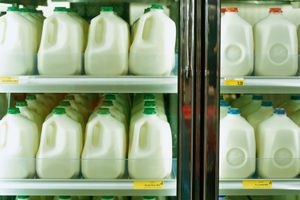2020 Outlook-3 Milk Market Factors To Watch
 The factors that drive milk prices are often complex. Dairy farmers recently walked through a three-year cycle of low prices, and while they significantly improved in the fourth quarter of 2019, questions about 2020 remain.
The factors that drive milk prices are often complex. Dairy farmers recently walked through a three-year cycle of low prices, and while they significantly improved in the fourth quarter of 2019, questions about 2020 remain.
Analysts say prices could range from $16 to $19.50 next year. Monitor the following three factors to determine price direction:
1. Dairy product values. According to milk market analyst Ted Jacoby III, Class III prices have been pulled up by short inventories of cheddar blocks paired with healthy demand. “Meanwhile, there has not been terribly great demand for cheddar barrels,” he says. “Yes, the market for cheddar barrels has been gyrating and the block barrel spread got as wide as 40¢ at one point and then closed back up to 20¢. It might close back up to 10¢ but the reality is what’s driving this cheese market right now is natural cheddar demand, not processed cheese demand, which translates to 40-lb. block demand rather than barrel demand.”
That concerns Jacoby because it shows there’s demand for young cheese, while old cheese sitting in refrigerated warehouses could eventually come back to “haunt the market.”
Additionally, U.S. prices compared to exporting countries is a concern.
“Typically, this time of year we transition from a holiday demand story into an export market story,” says Matt Tranel of Commodity Risk Management Group. Considering world markets, U.S. cheese prices are significantly higher than those in the Oceania and Europe. “We’re still 30¢ overvalued to the world market.”
In 2020, the market could see high cheese inventories influencing inventory builders’ decision-making process, according to Jacoby.
“I have concerns about the sustainability of this cheese market as we get into the middle of next year,” he says.
2. Global economics. “Most of the world right now is either in a recession or in the process of entering a recession,” Jacoby says. The U.S. economy is still healthy but Jacoby questions if it will stay that way. “The general consensus of economists that I pay attention to are basically saying we’re going to enter a shallow but lengthy recession sometime next year and it’ll last for a few years,” he says. “It won’t be 2009, but let’s call it a burdensome environment for a couple of years.” A recession would certainly hurt milk prices, particularly if milk production remains strong.
3. Milk production. It’s hard to forecast milk prices for 2020 without discussing fundamentals such as production. In 2020, there are several factors that could influence milk production. The first being feed quantity and feed quality.
“We have to factor in our feed quality, which right now is on the edge,” says Ted Jacoby Sr. “We have not had a good growing season, which is going to greatly affect the feed quality for the next year.”
According to Tranel, heifer inventories are another production factor to watch. “Many producers have been breeding their cows and heifers to beef, so the heifer inventory isn’t nearly as large as what it had been the previous how many years,” he says.
Lastly, high prices usually cure high prices, Tranel adds. If milk prices remain close to $20, farmers will likely push milk production higher as well. “Board prices at $20 invite expansion,” he says. “It won’t be everyone, but if prices hold we will see some expansion.”
Ultimately, Tranel says milk prices could range from a low of $16 to a high of $19.50, with an annual average of $17.50.
“Buyers are in a spot where they aren’t expecting as much milk availability as in previous years, with the exception being in Texas and the West,” according to Tranel. They’re more willing to set their budgets at a higher level. Given what happened in the second half of 2019, they aren’t wishing to buy a $20 market should it return in 2020, ” he adds.
Jacoby Sr. says he’s beginning to question $20 milk in 2020.
“Unless something happens with the juxtaposition of milk values in Europe versus the United States, it’s hard for me to say the United States markets are going be strong next year,” he says. “There are a lot of things that can happen between now and then to give us strength. Maybe feed quality is better than we thought, and maybe an increased departure of milk producers in the United States might have an effect. But given the current factors and the way we’re looking at it, it’s beginning to become suspect that this market will continue to move up as fast as we thought it would.”
Source: Anna-Lisa Laca, Milk
